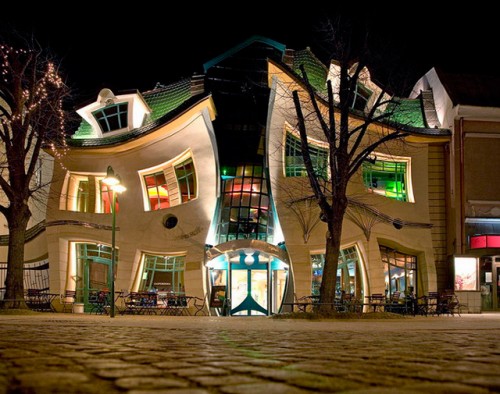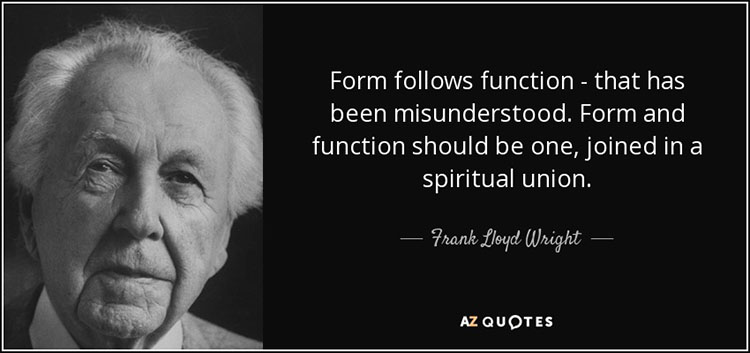
Form Follows Function “The Crooked House” Sopot, Poland
When I pressed a client recently to provide me with the content for her new website, she confessed to having trouble producing it. “Why don’t you show me some designs,” she asked, “and maybe that will help me write the content.” Alarms sounded in my head. Imagine this scenario. You hire an architect to design you a building. In your initial meeting she asks you a simple question: “What will be going inside the building“? You reply, “I don’t know yet but if you show me some designs I’m sure I’ll think of something.” Ridiculous right? It made me think.
Does “Form Follows Function” Apply to Web Design?
In a well researched and highly engaging article by Steven Bradley, Smashing Magazine tackles the question. And as it turns out, the answer isn’t black and white. The term was first coined by American architect Louis Sullivan in an 1896 article. He wrote:
“It is the pervading law of all things organic and inorganic, of all things physical and metaphysical, of all things human and all things superhuman, of all true manifestations of the head, of the heart, of the soul, that the life is recognizable in its expression, that form ever follows function. This is the law.”
Ironically, it was Sullivan’s most gifted student, Frank Lloyd Wright, who adapted the axiom to changing technologies in the field of architecture:

Bradley’s study reveals many instances in which form does not follow function… in nature for example. Says Bradley, “evolution passes on genetic traits to subsequent generations without any rationale for their purpose. Each generation of a species then finds a use for the form it has inherited. Function follows form in nature“.
Fair enough.
Content First, Design Second
The form follows function axiom is simply too broad and high minded to apply in any meaningful way to the relationship between a website’s design and its content – that is to say content as distinct from functionality. In my practice, content first, design second is a rule of thumb that makes more sense and has more practical applications. Simply put, a website’s content should inform its design, not the other way around. Jeffrey Zeldman, one of the leading minds in web standards in the last twenty five years puts it this way:
Content precedes design. Design in the absence of content is not design, it’s decoration.
What Are You Trying to Say and Who Are You Saying it To?
So what about my client who asked me to show her some designs before she could write the content? My advice to her was this. Think about what you are trying to say and who you are saying it to. Then put it all down on paper without thinking about color, layout, proximity, or any other elements of look and feel. That way you will ensure that your content is not being influenced by design. Then let’s review it together. We’ll talk about ways to ensure that your message is being read – things like bullet lists, text boxes, call-to-action elements, use of color and shape. Yes, it’s possible to start the process with a beautiful design then try to make the content fit. But like the building pictured above, it will eventually cave in on itself.
Now Back to You
When you built your website, assuming you have one, how did the process go? Did you produce the content first or was it the other way around? If you worked with a web design firm, how did they approach the process? I’d love to hear from you.

Great post! As you know from my experience working on our Amtrak
department website, developing content was the most frustrating part of
the project. We wanted it to be mostly graphic and not have too much
textual content. But as you mentioned in the post, you really needs to
think about the purpose and need, and goals and objectives of the
website. Why do you need a website? What are you trying to communicate,
and to whom? What are you trying to achieve? All of that stuff. And at
the time, our department was evolving due to a massive corporate
reoranization, so we had no idea what our message really was. Needless
to say, we ended up putting the project for hold for 8 months.
I feel that I have always been a practical and
rational designer, so form follows function makes the most sense (at
least to me). Professors would always push you to design these new and
creative solutions for the same age-old problems, when a simple
structure would do just fine. Looking back, our professors wanted us to
create interesting forms, but the challenge was designing it to be
functional. That rarely happened (especially for us students). So I
suppose Mr. Wright was right on the money. Of course websites can be
constructed without the proper content, as well as new homes designed
without the owners programmatic requirements, but that is bad design and
a bad finished product.
Anthony, thanks for your thoughtful comments. As an architect I knew you would have an interesting take on the form follows function axiom. Sounds like you lean toward simplicity in design. I can certainly relate to that since I lean that way myself in web design.